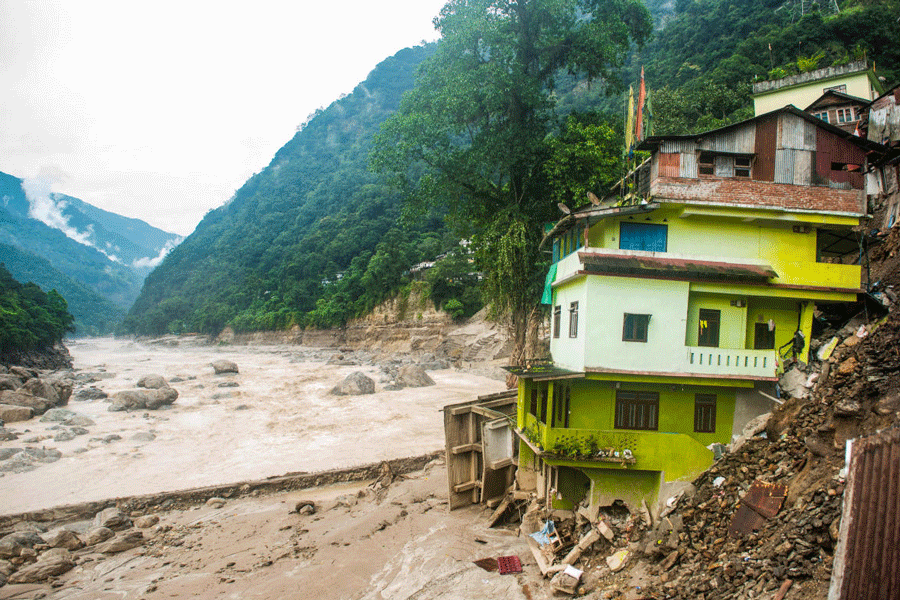He is what you may call a river whisperer, though his day job is being chairman of the West Bengal Pollution Control Board.
There is an anecdote about Kalyan Rudra and Gopalkrishna Gandhi. When the latter was Governor of West Bengal, he requested a meeting with Rudra. At the time Rudra was teaching in a college; he is a geographer by training with a specialisation in rivers and water management. “I have many questions about the environment, the rivers, air quality (of West Bengal),” Gandhi said to him. He had met activist Medha Patkar and she had suggested he speak to Rudra. “Kalyan is a teacher who can simplify the matter for you,” Patkar had said.
This is as good a time as any to tap into Rudra’s expertise. In the past many months, there have been reports of floods from Sikkim, Bengal, Uttarakhand, Punjab and Delhi. Parts of Himachal Pradesh received over 12 inches of rain. Rudra says, “The Himalayan rivers are being tortured.”
He continues, “Short duration heavy intensity rainfall is a result of climate change. But the effects of climate change are being aggravated by large-scale human intervention.”
Rudra talks about rivers with so much feeling that they acquire human qualities in the mind of the listener. As for humans, they sound like a dehumanised pack, driven by an insatiable appetite — reckless dam-building, drastic modification of hill slopes, widening of roads, extensive deforestation, construction of hotels and resorts, four-lane roads in the offing in the Himalayas, linking the Char Dham by highways, building dams in the Garhwal Himalayas and the consequent sinking of Joshimath and Uttarkashi.
He leans in conspiratorially, “People think the river has a right bank and a left bank and it flows through the middle. That is not correct. When a river is in spate during rains, it shifts, and there should be floodplains to accommodate the change in river flow. But what we are doing is building on the floodplains.”
Rudra can steer a conversation about rivers in any direction he chooses — hills to plains, present to distant past to recent past.
Bengal is nourished by many rivers — the Ganges, Brahmaputra, Meghna. It has been this way for the last 12,000 years. Rudra talks about how in the 21st century, Bengal has turned into a sediment-starved delta. He says, “That the land subsided is borne out by evidence. Like when the port was being developed at Canning, many fossils of sundari trees were found; it was as if they had been standing there. Again, when Sealdah station was developed, many more fossils of sundari trees were found as if they were standing on the surface of the earth and were later buried by an earthquake.”
It is his informed guess that an earthquake and consequent subsi- dence of land might have caused the decline of civilisation that flourished along coastal Bengal. There is next to no recorded history of these parts between 1200 AD and 1800 AD.
When British cartographer James Rennell was surveying Bengal between 1764 and 1777, he observed that Bakharganj, now situated in Bangladesh, was destroyed by Mog pirates. Rudra says in his whodunnit tone, “But an advanced civilisation cannot be destroyed totally by Mog pirates. I think something happened. A sudden earthquake perhaps. Even now a slow subsidence is happening at the rate of three millimetres per year.”
The narrative continues. How British civil engineer William Willcocks writes about the people of Bengal learning to live with floods. They knew floods had many ecological roles. Floodwater carries nutrients. Sediment dispersion brings renewed fertility to the soil. These things made Bengal ecologically very productive.
B. Hamilton writes in Geographical, Statistical and Historical Description of Hindostan and Adjacent Countries in 1820 that Burdwan ranks first in agricultural productivity in all of India. “Such a productive land gradually declined under the British because they tried to control floods,” says Rudra.
As Rudra tells it, there was a time when floodwaters would recede in a day or two. But when the British built the railways, they did not leave enough space for the floodwaters to pass. Embankments were created and these led to waterlogging, which in turn meant greater breeding ground for malaria. Earlier, the floodwaters would bring in silt and small fish, and the fish ate mosquito larvae. After the rail constructions, the waters were constricted and the sediment dispersal did not happen. All the sediment was now deposited on the riverbed and the river itself was its own decayed version.
According to Rudra, the British engineering logic had been superimposed on a geographical condition that the British scarcely understood. The British left but the river management philosophy continues.
Are you still blaming the rivers?










